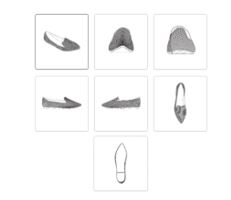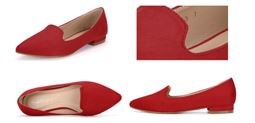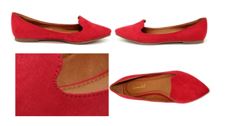March 16, 2021
Facts
On 24 November 2017, Rothy’s Inc, launched its Pointed Loafer shoe, a type of ballerina shoe with a pointed toe and a protruding tongue that gives the appearance of a loafer:

The Pointed Loafer had been preceded to market by two of Rothy’s other shoes, known as The Flat and The Point. It was common ground that these were the first ballerina shoes to be made of knitted yarn made from recycled plastic.
In around April 2019, the Austrian shoe company, Giesswein Walkwaren AG (GW), began marketing through its website a range of ballerina shoes the upper parts of which were in a knitted meshwork fabric made from recycled plastic. Those shoes included the Pointy Flat:

In July 2019, Rothy’s issued proceedings against GW, alleging that the Pointy Flat infringed two of its EU-wide design rights:
- a registered Community design filed and registered on 9 November 2017 (the RCD); and
- unregistered Community design right in the design of the Pointed Loafer as first disclosed in the EU on 24 November 2017 (the UCD).
The RCD includes seven views:

The UCD arose from the disclosure of images of the Pointed Loafer on Rothy’s website, in emails sent to people based in the EU and on various social media sites, for example:

GW counterclaimed for invalidity of the RCD and the UCD on the basis of two prior designs (the Prior Designs):
i) the Allegra K shoe:

and ii) the Bonnibel shoe:

Decision
Invalidity of the RCD
The question for Mr David Stone, sitting as a Deputy High Court judge, was whether the RCD produced a different overall impression than the Allegra K and/or the Bonnibel on the informed user.
Referring to the six stage summary on overall impression, as set out in Cantel Medical (UK) Ltd v ARC Medical Design Ltd [2018] EWHC 345 (Pat), the parties agreed that:
- the relevant sector was ballerina shoes for women;
- the informed user was a user of ballerina shoes, not a designer, technical expert, manufacturer or seller; she was particularly observant, knowledgeable of the design corpus and the design features normally found in the design of ballerina shoes; she was interested and showed a relatively high degree of attention; she neither observed minimal differences in detail, nor did she merely perceive the designs as a whole; she conducted a direct comparison of the design with the relevant product (the prior design or the allegedly infringing design);
- the designer of ballerina shoes had a very wide degree of freedom in developing the design; the design corpus showed that ballerina shoes differed in shape, texture, colours and materials; and
- there were no features of the RCD that were solely dictated by technical function.
Mr Stone also took into account the fact that the informed user may sometimes discriminate between elements of the respective designs, attaching different degrees of importance to similarities or differences.
Comparing the seven views of the RCD with the Allegra K, Mr Stone concluded that the Allegra K shoe produced a different overall impression on the informed user than the RCD.
The main differences were:
- the heel: the heel on the RCD was significantly less pronounced; unlike the heel of the RCD, the heel of the Allegra K was two-toned, with the upper half to two thirds of the heel covered in the same material as the upper, which would strike the informed user as a very significant difference;
- the material of the upper: the Allegra K was made of suede, which was a very different material to the knitted heavy yarn in the RCD, which expert evidence showed was an “interesting design feature” that made it “unique”; the knitted yarn would strike the informed user as a new departure; and
- counter-line: the Allegra K did not feature a counter-line down the side of the back of the shoe, which was obvious in the RCD.
As for the Bonnibel, GW admitted certain differences between it and the RCD including:
- the Bonnibel was made of suede, synthetic suede or microsuede; and
- the Bonnibel did not feature a counter-line, which was obvious in the RCD.
Again, Mr Stone said, the different material meant that the Bonnibel produced different overall impressions on the informed user. Unlike the Allegra K, the Bonnibel lacked a high, two-toned heel, but it was made of suede or synthetic suede, clearly not a knitted material.
The invalidity attack on the RCD therefore failed.
Infringement of the RCD
Comparing the drawings in the RCD with GW’s Pointy Flat, Mr Stone found that whilst there were undoubtedly differences between the two, when the informed user stepped back and formed an overall impression, it was the same. Both the RCD and the Pointy Flat were pointed-toe slipper cut ballerina shoes, with a low heel, obvious counter-line, protruding tongue and recognisable gussets. What would most strike the informed user was that both the RCD and the Pointy Flat had uppers knitted from a heavy thread, which was a departure for ballerina shoes. In reaching that conclusion, Mr Stone considered the very large design freedom the designers had.
Accordingly, the Pointy Flat infringed the RCD.
UCD infringement
On the question of copying, the evidence showed that GW had undertaken internet research and had purchased samples of previous incarnations of Rothy’s Pointed Loafer shoes made of recycled plastic knitted yarn, namely the Flat, the Loafer and the Point. Those shoes were thoroughly analysed and used throughout the process of designing the Pointy Flat. However, the witness evidence from two of the three GW designers was that they had never seen Rothy’s Pointed Loafer, and therefore could not have copied it; they did not shift from that stance during cross-examination.
Mr Stone found that disclosure had been properly conducted and that GW had been upfront about the shoes it had bought. Further, Mr Stone declined to draw a negative inference from the fact that one of the three designers of the Pointy Flat was not called to give oral evidence.
As for unconscious copying, Mr Stone said that this submission was “far-fetched”. There were no images of Rothy’s Pointed Loafer in the disclosure from GW. Further, the Pointed Loafer was not on Rothy’s website at the time the GW designers undertook their internet research.
Mr Stone also found GW’s evidence of independent design to be “coherent and consistent”. The GW designers had taken inspiration from the three Rothy’s shoes they purchased, two of which had a rounded toe, and one a pointed toe. Mr Stone said it was a “small and readily apparent step for an entity wishing to make a pointy-toed ballerina shoe to do so”.
Accordingly, the allegation of copying failed.
The claim for UCD infringement therefore failed. However, Mr Stone also briefly considered overall impression, in the event that he was wrong on the copying issue, finding that the UCD and the Pointy Flat did produce on the informed user the same overall impression.
UCD invalidity
Mr Stone also found that neither of the Prior Designs created the same overall impression on the informed user as the Pointed Loafer. Accordingly, the UCD was not invalid over the Allegra K or the Bonnibel. (Rothy’s Inc v Giesswein Walkwaren AG [2020] EWHC 3391 (IPEC) (16 December 2020) — to read the judgment in full, click here).
Expertise